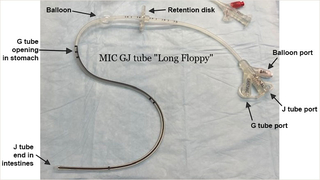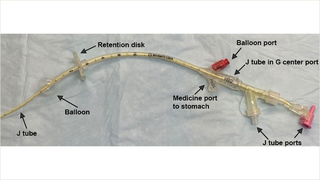Patient Instructions: Long, Floppy Balloon Gastro-Jejunostomy tubes (GJ tubes)
These instructions are for Children’s Hospital of Philadelphia (CHOP) patients with long, floppy balloon GJ tubes, such as MIC® balloon GJ tube or balloon G tube with a Corflo® J tube.
Important information about long, floppy balloon GJ tubes:
- A GJ tube, is two tubes in one: a G tube (gastric tube) in the stomach and a J tube (jejunal tube) in the small intestine. This type of tube is used for children who need to be fed into their small intestine and need to be given medicine into their stomach or have their stomach vented.
- GJ tubes must be placed during an x-ray to make sure that the end of the tube is in the right place.
- A balloon is filled with water inside of the stomach to prevent the tube from falling out. A retention disc is pushed down along the outside of the tube to also keep the tube secure.
- There are two main types of long, floppy GJ tubes that are held in place with a balloon:
A long, floppy balloon GJ tube has 3 ports. One is for the stomach (gastric port), one is for the intestine (jejunal port), and one is for the balloon. Do NOT use the balloon port for feeding or medicine.

The second type of long, floppy GJ tube is made when a thinner feeding tube is threaded through a G tube and into the small intestine (jejunum). This tube also has three ports. The center G tube port is funnel-shaped with a cap. The thinner J tube is threaded through the center G tube port. J tube has 2 ports for giving feedings and medicine into the small intestine. The medicine port on the side of the G tube is smaller and has a cap. It is used for giving medicine into the stomach. The balloon port is used to fill or let water out of the balloon. The balloon port should not be used for feeding or medicine.

No matter which type of tube your child has, the tube will need to be replaced every 3-6 months. Call the Interventional Radiology Department to schedule routine tube changes.
Instructions for care of the tube:
Your child’s tube should not interfere with their normal activities. They can bathe, swim, play and sleep as usual. You may find certain clothing, such as onesies, help to keep your child from pulling on the tube or having the tube catch on something and pull out.
- When the tube is placed, a tract is created from the stoma, or tube insertions site, into the stomach. It is important to prevent the tube from coming out or moving. If the tube moves out of place it can cause leaking, skin irritation and granulation tissue.
- You may tuck the tube into your child’s clothing, but not near their diaper area.
- ElastiNet®, a stretchy elastic net dressing, may also be used to keep the tube close to your child’s body.
- Wipe the tube regularly with alcohol to prevent the buildup of oil on the tube and prevent movement of the retention disc.
- Push the disc down to the skin to hold the tube in place. Your team will tell you what number should match up with the disc. This way you can make sure the tube has not moved.
- If the tube is not at the correct number, gently tug on the tube. Tugging brings the balloon up against the inside wall of the stomach.
- The tube may be taped so that it does not move out of place. If the tape becomes loose, do not remove it. Reinforce it with more tape and call Interventional Radiology.
Instructions for skin care:
Wash around the stoma and surrounding skin with mild soap and water every day, or more often if needed. Be gentle. Scrubbing can slow down healing or cause skin breakdown. Rinse with water and dry well. It is normal to have a little yellow-brown drainage and redness at the opening.
Call your child’s healthcare provider if you see:
- Rash with red dots on the edges
- Infection: increased redness, swelling, yellow-green drainage with a bad smell at the stoma, pain
- Open areas of skin around the stoma
- Bleeding at the stoma site
- Bleeding, painful or growing granulation tissue around the stoma
- Increased leaking at the stoma site
- Vomiting of formula when on “J” feedings
Instructions for leaking:
- Make sure the tube has not moved by checking the number at the disk.
- If there is leaking at the stoma site, check the amount of water in the balloon.
- Hold down the disc against the belly and pull back on the balloon port with the syringe that comes in your GJ tube kit. Check the amount of water that you have pulled into the syringe.
- If there is less than the usual amount, add water. Only check the water in the balloon if there is leaking.
- Balloon volumes are different based on size and type of tube. Talk to your healthcare provider about the right amount of water for your child’s tube. If the balloon contains the correct amount of water, but is still leaking, add 0.5 ml to 1 ml of water at a time to the balloon until the leaking stops. Never have more than the maximum recommended amount of water in the balloon. If you add too much water to the balloon, it may break or cause a blockage.
- If leaking continues, call Interventional Radiology.
- While you are waiting to get instructions, keep your child’s skin dry by changing any wet gauze or dressing under the tube as needed.
- Protect the skin around the stoma with a skin barrier, such as Vaseline®, A & D® ointment, diaper cream, or Cavilon™ No Sting Barrier Film (if your child is over 1 month of age).
Instructions for treating granulation tissue:
Granulation tissue is a type of scar tissue that forms when the body is trying to heal itself. Because the feeding tube stoma is a new opening, your child’s body naturally may try to close it by growing this tissue. Some children have granulation tissue that grows very quickly, while others have no problem with it at all. Granulation tissue is dark pink or red. Sometimes it can cause leakage and skin irritation. It may also bleed or cause pain. If this happens contact your healthcare provider.
- If you see granulation tissue starting to grow, discuss it with your healthcare provider at your next visit.
- If the granulation tissue around the tube is bleeding, painful, or growing quickly, contact your healthcare provider for an appointment. They may prescribe a cream that you can use at home, or they may treat it in the office with a medicine called silver nitrate. These medicines shrink the granulation tissue. Granulation tissue may return and need to be treated with medicine again.
Instructions for venting the gastric port:
J tubes do not need to be vented, but G tubes may need to be. Venting is a way to use the tube to burp your child and let gas out of their stomach. Your child may need to be vented if their belly is bloated, if they have belly pain, or if they gag, retch, or vomit.
If your child’s G tube needs to be vented, follow these steps:
- Remove the plunger from a catheter tip syringe.
- Attach syringe barrel with the plunger removed to the G tube port.
- Hold the syringe barrel above the level of your child’s stomach.
- Keep the tube vented for 5-10 minutes before and after feeding and as instructed.
Instructions if the tube becomes clogged:
- Try to prevent the tube from clogging. The J tube can clog easily and needs to be flushed with 5-10 ml water throughout the day, even on continuous feedings and before and after all feedings and medicine. The G tube needs to be flushed at least once a day.
- If the tube becomes clogged, attach a 5ml oral syringe with warm water to the end of your feeding tube. Try to flush the tube. If you are unable to flush, pull back on the plunger of the syringe. Repeat this push and pull action up to 5 times. If you still cannot flush the tube, try using warm water in a 3ml or 1ml oral syringe and repeat the above steps.
- If you still cannot flush the tube, use the Clog Zapper® kit as you were taught. Clog Zapper is a ready-to-use kit containing a powder that helps break up clogs in feeding tubes. Clog Zapper contains maltodextrin, a type of sugar. If your child is on a ketogenic diet, they will need microlipids once the tube is unclogged. Talk to your healthcare provider about how much to give. Clog Zapper also contains coconut and should not be used in those with tree nut allergies.
- If this does not work, call Interventional Radiology.
Instructions if the GJ tube comes out:
No matter how long your child has had a GJ tube, the stoma can close very quickly.
- Put water-soluble lubricant on the end of the tube. Insert the end of the tube into the stoma about 1 to 2 inches. Do not force the tube if you meet resistance. Tape the tube in place. The tube will keep the stoma from closing.
- Do not feed your child through the tube.
- Call Interventional Radiology right away.
Call your CHOP team with any questions or concerns.
If you have any questions about your child’s health, please contact your child’s healthcare provider. This document is intended only to provide general educational information and is not intended as medical advice or treatment. Please consult with your healthcare provider prior to use, as some of this information may need to be adapted for your child’s specific needs. It is the responsibility of your healthcare provider to advise you on the appropriate use of this information. If you/your child are not already a CHOP patient, this document does not create a doctor-patient relationship between you/your child and CHOP. CHOP is not responsible for any outcomes you/your child might experience from your use of this document. This document is provided "AS IS", WITHOUT WARRANTIES OR CONDITIONS OF ANY KIND, express or implied. If this document refers to any drugs or medical devices, it is the responsibility of your healthcare provider to check the FDA status prior to use. If this document includes references to drug dosing, please do not rely on this document. Your healthcare provider should check the package insert for each drug before use. Hyperlinks used within this document may not be translated into other languages.
©2022 Children’s Hospital of Philadelphia. Not to be copied or distributed without permission.